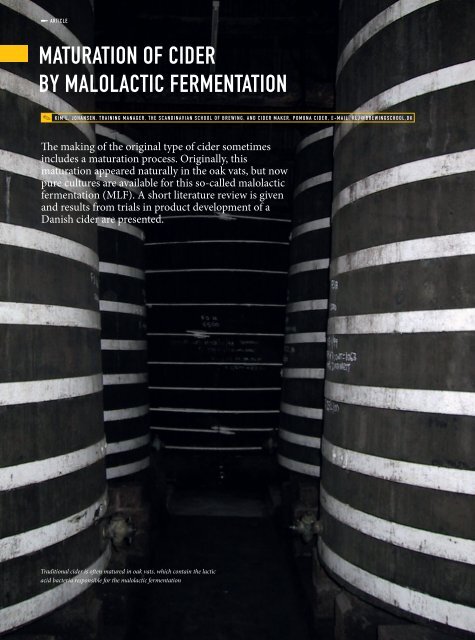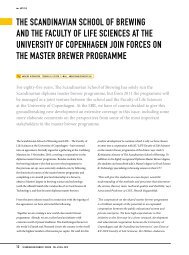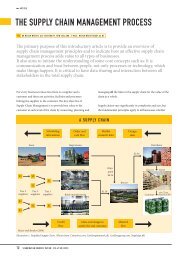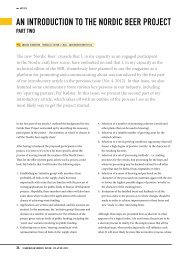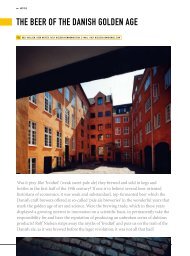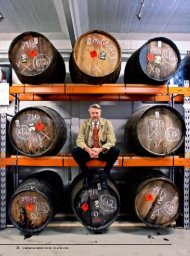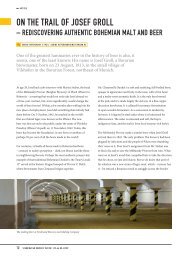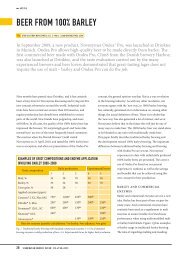MatUratiON OF ciDer BY MalOlactic FerMeNtatiON - Scandbrewrev.dk
MatUratiON OF ciDer BY MalOlactic FerMeNtatiON - Scandbrewrev.dk
MatUratiON OF ciDer BY MalOlactic FerMeNtatiON - Scandbrewrev.dk
- No tags were found...
Create successful ePaper yourself
Turn your PDF publications into a flip-book with our unique Google optimized e-Paper software.
MATURATION <strong>OF</strong> CIDER <strong>BY</strong> MALOLACTIC FERMENTATIONLike in wine, traditional cider often undergoes a secondarymalolactic fermentation, whereby lactic acid bacteria convertmalic acid into lactic acid. The sharp acidity of malic acidfrom the apples is substituted by the more soft acidity oflactic acid. The dicarboxylic acid malic acid is decarboxylatedinto the monocarboxylic acid lactic acid and carbon dioxide.The reaction is catalysed by the enzyme MLE (malolacticenzyme). In Lactobacillus collinoides, the enzyme is foundto have a pH-optimum of 4.9 and was repressed by applesugars. Other organic acids play an important role duringmaturation. Quinic acid and shikimic acid are converted todihydroshikimic acid and acetic acid and succinic acid areproduced by the lactic acid bacteria. Even a decrease in lacticacid has been observed.The lactic acid bacteria responsible for the MLF are foundin the oak vats. The predominant lactic acid bacteria arefound to be Lactobacillus plantarum in English cider vatsand Oenococcus oeni (former Leuconostoc oenos) in Frenchcider. In Spanish cider, Oenococcus oeni (Leuconostoc oenos)The optimal storage temperature for English cider was foundto be 15 °C and to be 22 °C for Spanish cider. In England,the cider is normally matured at room temperature, whilein France, the temperature is lower at 10-15 °C. Dissolvedoxygen in the cider during storage was found to giveundesirable oxidation flavours. Re-constituted concentratewas found not to promote the desirable flavour changes asfresh apple juice did, due to the lack of MLF.Continuous culturing of lactic acid bacteria for malolacticconversion has been made with success. Differences ingrowth kinetics were found between Oenococcus oeni andLactobacillus brevis.In laboratory scale, successful trials have been performed withimmobilisation of yeast and lactic acid bacteria in order toobtain simultaneous alcoholic and malolactic fermentation.Saccharomyces cerevisiae and Lactobacillus plantarum havebeen co-immobilised on a sponge-like matrix, Oenococcusoeni (Leuconostoc oenos) has been immobilised in Ca-alginateoo hoh oThe process ofmalolactic fermentationoo ho ho h + c o 2and Lactobacillus species have been found responsible forMLF. Other lactic acid bacteria belonging to the generaLactobacillus, Leuconostoc and Pediococcus have also beenidentified. The MLF is reported to appear above 1 millioncells/ml of lactic acid bacteria. Application of a malolacticstarter culture of Oenococcus oeni on an industrial scale wasperformed with success in production of Spanish cider.and Saccharomyces bayanus and Oenococcus oeni (Leuconostocoenos) have been co-immobilised in a Ca-alginate matrix.However, a lower content of higher alcohols and a highercontent of diacetyl have been found. Immobilisation ofOenococcus oeni in alginate beads showed better flavourcharacteristics than free cells. Immobilisation in generalimproves separation.In English and French cider making, the MLF takes placeafter the alcoholic fermentation. In Spanish cider, it isreported to take place simultaneously with the alcoholicfermentation. Inoculation with pure yeast and bacterialcultures in Spanish cider shows that sequential fermentationsare preferred to simultaneous fermentations. Yeast extractand fermentation lees are reported to have a positive impacton MLF. The maturation normally takes from one to fourmonths, but up to two years is practised.In a previous paper, an overview of the entire process of cidermaking has been given.PURE LACTIC CULTURESIn trials at the author’s private premises, MLF was obtainedapplying pure cultures of Oenococcus oeni added after the mainfermentation. The conversion took 11 days without sulphitingthe juice before the main fermentation and up to 21 days if upto 60 ppm sulphite was added before the main fermentation.SCANDINAVIAN BREWERS’ REVIEW . VOL.67 NO.3 2010 19
MATURATION <strong>OF</strong> CIDER <strong>BY</strong> MALOLACTIC FERMENTATIONg / l87654321008765m l f s5 1 0 1 5 2 0 2 5 3 0 3 5 4 0D aym l f cDuring the product development of a Danish medium drycider, trials were made to establish whether a malolacticfermentation were to take place in order to improve the flavourof the product. Trials were made with three different strains of apure culture of the lactic acid bacteria Oenococcus oeni:• MLF S: a lactic culture used only for trials– not commercially available• MLF C: a lactic culture for maturation of cider• MLF V: a lactic culture for maturation of white wineAn apple juice at 11.5 °Brix was added a pure yeast cultureand fermented to dryness at 15 °C. The cider was then splitinto three batches, to which each of the three pure lacticcultures was added. The conversion of malic acid to lactic acidwas followed during the maturation.g / l4321080 5 1 0 1 5 2 0 2 5 3 0 3 5 4 0D ayThe trials showed that MLF V was faster in converting malicacid than MLF C, which again was faster than MLF S. Asimilar situation can be seen for initial lag period before thefermentation begins. MLF V was selected for production,during which the MLF takes two to three weeks.7g / l6543210m l f v0 5 1 0 1 5 2 0 2 5 3 0 3 5 4 0D aym a l i c a c i dl a c t i c a c i dConversion of malic acid to lactic acid by 3 different strainsof Oenococcus oeni1 09876543210n o m l f m l f c m l f va c i d i c m a l i c a c e t i c l a c t i cSour taste sensations for cider with and without malolacticfermentation (scale 0-10)20 SCANDINAVIAN BREWERS’ REVIEW . VOL.67 NO.3 2010
<strong>MatUratiON</strong> <strong>OF</strong> <strong>ciDer</strong> <strong>BY</strong> <strong>MalOlactic</strong> <strong>FerMeNtatiON</strong>The trials and later productions have all showed that aquantitative conversion of malic acid into lactic acid takesplace. In the apple juice, there is typically 7.0 g/l malic acid,which is converted into 4.7 g/l lactic acid (52 mM). Duringthe conversion, pH raises from typically 3.0 in the fermentedjuice to 3.5 in the matured cider.TASTE TESTINGTriangular taste testings were performed to establish if theMLF had any effect. The tests showed a significant differencebetween no MLF and MLF C with a preference for MLF C.Triangular tests also showed a significant difference betweenMLF C and MLF V, but with no preference.A profile tasting was performed by a panel of trained beertasters. The sour taste sensations malic (apple), acetic(vinegar), acidic (citric, sour) and lactic are pictured above.CONCLUSIONThe product development can be concluded as follows:During the malolactic fermentation, malic acid is quantitativelyconverted into lactic acid. The rate of conversion depends onthe strain of lactic acid bacteria. There is an increase in pHduring the MLF.It is possible to taste if the MLF has taken place due to adecrease in acidity. Cider with MLF is preferred to no MLF.There is a difference between the pure lactic acid culture strains.ACKNOWLEDGEMENTSThanks are due to the Danish Food Industry Agency under theMinistry of Food, Agriculture and Fisheries and to Ørbæk JuiceFactory for support to the project: development of strong ciderbased on Danish apples.The taste is significantly more acidic and slightly more aceticwithout MLF when compared to the two lactic cultures MLFC and MLF V. The lactic acidity in the MLF treated ciders is ata low level. The difference in malic acidity is not significant.REFERENCESThe author of this article has a complete list of references forthe background statements and results referred to in this articlewhich can be obtained by contacting the author.Source: NACMScaNDiNaViaN BreWerS’ reVieW . VOl.67 NO.3 2010 21


